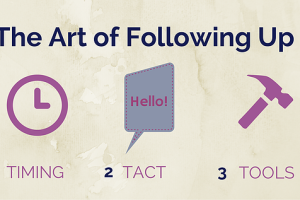In a sophisticated world like ours, it never hurts to revisit the basics from time to time. One of the “basics” we’re prone to overlook in sales is well summarized by the maxim, “Qualify, qualify, qualify.” That is, in our rush to close as many deals as possible, we tend to chase a lot of fruitless leads—prospects which initially appear promising but which never quite pan out, usually for reasons that, if we’re honest, we recognize should have caught our attention well before we got so far along in the process. Good lead qualification, therefore, is a fundamental part of the salesperson’s job, and it’s something even the best salespeople occasionally need to rethink. Today, we’re going to talk about three tried-and-true strategies for making the most of the process.
1. Know what (and who) you’re looking for.
Good qualification begins with thoughtful planning, making sure we know exactly what kind of customer we’re targeting in the first place. We know this intuitively, but for some reason we tend to find ourselves three or four steps into the sales process before thinking about it. That’s a recipe for wasted time and frustrated personnel. The first thing salespeople need to realize is that not every sales opportunity is worth jumping at – we cant lose sight of the bigger picture of how the sale will play out down the road. The decision to pursue (or not to pursue) a particular lead ought to be a very deliberate one, arising both from careful consideration of a prospect’s observable qualities and from a reasonable estimate of the deal’s potential value relative to the cost of pursuit. If we spend just a little more time and effort investigating our leads before making contact with them, we can spare ourselves a lot of wasted time and effort later on when one or more of them ends up being a poor fit.
We can learn much about a lead without talking to anyone. Things like company size, major product offerings, leadership structure, and reputation in the marketplace can all be discerned by mean of some creative Internet research. In just a few minutes, we can form provisional answers to such questions as, “Will this company be able to afford the kind of solution I’m proposing?” or “Which individuals within the organization are most likely to appreciate the value of my offering?” and even “What kinds of problems is this company likely facing as it competes in this market segment?” Even if the answers we arrive at aren’t quite accurate, they give us an educated starting point for the first sales conversation, allowing us to more quickly build rapport.
Here’s some advice for those first sales calls… it involves the importance of legitimizing a prospect early on in the qualification process, seeking out red flags of disinterest before unnecessary resources are expended in pursuit of the sale. Savvy salespeople always determine whether our prospect is serious or trying to (politely) get rid of us. And you have to be original – no ‘canned’ nonsense. If you don’t, you run the risk of losing a potentially genuine opportunity because you were too lazy to step up to the plate. That’s not to say, of course, that we give up the first time a prospect says “no.” Persistence is a virtue, remember. But it does mean that we recognize the difficulty of winning over a truly disinterested, apathetic, or downright hostile client—even when they may have a genuine need for the kind of solution we have to offer. There’s no use spinning our wheels chasing someone who’s not prepared to buy.
We also need to make sure we’re connecting with the appropriate people—the ones who, given enough interest, can leverage their influence to push a deal through to completion. In today’s world, purchasing is now done ‘by committee’. The leads we speak to during the sales process may not have the sole decision to approve a deal on the spot, but these leads will definitely impact the decision making process. In other words, we don’t necessarily need to be targeting the final decision-maker in a complex sale; we just need to make sure we’re targeting whoever in the organization wields the greatest influence over the decision-making process, whether that be a top-level executive or a bottom-level subject matter expert. If we find it difficult or impossible to gain access to these influencers, then chances are we’re not dealing with a realistic sales opportunity, and it’s time to move on.
2. Use well-directed questions.
Asking the right questions during a sales call requires an artisan’s skill and a counselor’s sensitivity. That’s because today’s busy executives are inundated with sales messages, and they’re skeptical of salespeople’s motives—often rightly so. When we ask too many questions, we risk putting our leads on the defensive, wary of being manipulated into divulging more about themselves than they really want us to know. Yet, when we ask too few questions, we risk overlooking a key piece of information concerning the client’s needs or the solution required. Since at least some direct questioning will be necessary in order to effectively qualify a lead, we have to choose our words carefully, making sure that each question keeps the client liberally talking about the things we need to know in order to decide whether and how to move forward.
One basic principle to apply when generating well-directed questions is to keep them open-ended. These are the kind that can’t be answered with simple one- or two-word phrases, especially “yes” or “no.” Open-ended questions require some kind of elaboration, so, for instance, instead of asking, “Do you currently have a system in place for handling this sort of workload?” we would say, “That seems like a peculiar workload for your present system. How are you handling that right now?” Instead of asking for the name of a particular engineer in charge of a project, we would say, “What kind of experience does your lead engineer have in this field?” These are the sorts of things that keep the attention squarely focused on what prospects most like to talk about: themselves.
Skilled salespeople are also masters of conversation. They artfully draw out their prospects’ interests by using well-timed “leading” statements that get prospects talking passionately about the things that matter most to them. Strictly speaking, statements like, “Your company seems to take its reputation very seriously,” or “That’s a unique approach to dealing with this problem,” require no response; yet they are more likely to elicit one than direct questions on these topics would. Lead in questions like these elicit a much easier way to spontaneously share information as it can be delivered in a conversation rather than a Q&A. One of the surest ways to shut the door on a sales opportunity is to make a prospect feel as though they are being interrogated rather than engaged. Well-directed questions arise organically, in the context of genuinely stimulating conversation. They invite prospects to elaborate on their answers, which yields far more revealing portraits of their needs and the potential obstacles to doing business with them than we could obtain by simply asking pointed questions up front.
3. Segment your prospects.
As the conversation begins winding down, it’s helpful to get the client to paint a picture of what the likely next steps would be in doing business. This will help us determine whether there’s a potential deal in the works or not. The classic “trial close” during which we test whether we’re dealing with someone who has the influence and financial ability to pull the trigger on a solution and whether the needs we’ve uncovered are sufficiently compelling to motivate action. If the response seems to be an indeterminate “I’ll get back to you,” it’s possible that the problem under discussion is not pressing enough to warrant priority attention right now. This would be a “C” deal—not necessarily off the table, but also probably not worth pursuing very aggressively at the moment. If, on the other hand, the response is, “Let me get with my purchasing team this afternoon and we’ll talk again soon,” then we have an “A” deal on our hands—something that we can reasonably expect to close within a matter of weeks and which, therefore, should get the bulk of our attention. Anything that falls between these two might be called a “B” deal, something that we would want to periodically follow up on to help the customer progress toward a decision.
By segmenting our leads this way, we can make sure we’re devoting our limited resources—especially time—to those that are most likely to close, while simultaneously nurturing secondary opportunities in the hopes of converting them to more urgent ones. It’s important for us to realize in doing so that all three classes of leads are vital in a healthy sales pipeline. As veteran entrepreneur Mark Suster states so well, “Today’s C deals are obviously tomorrow’s A’s & B’s.” We do well to remember that; otherwise we risk “qualifying” practices that are tantamount to a process of elimination for all but the most immediate leads.
Everyone loves low hanging fruit, but the best sales results come from a longer-term process of building relationships and nurturing sales leads until they’re ready to buy from you. We must be patient, we must be organized, and we must be deliberate in nurturing these longer-term leads until a purchasing decision is to be made. But a different overall approach is in order as these leads don’t have a vested interest in what we have to say (just yet), so we must be concise and keep our communications relevant to expressed interests. In other words, we have to earn the right to become a conversation partner. We have to demonstrate that we’re “in the know” about the things that matter most to our clients so that they’ll actually want to sit down and talk about solutions.
To paraphrase all we’ve talked about so far, one might conclude that effective lead qualification really boils down to three main skills: observation, conversation, and organization. We’re not accustomed to thinking of these as sales skills per se, but only when we master them will we be able to consistently identify who is ready to buy and who is just anxious to go back to whatever they were doing before we interrupted them.








